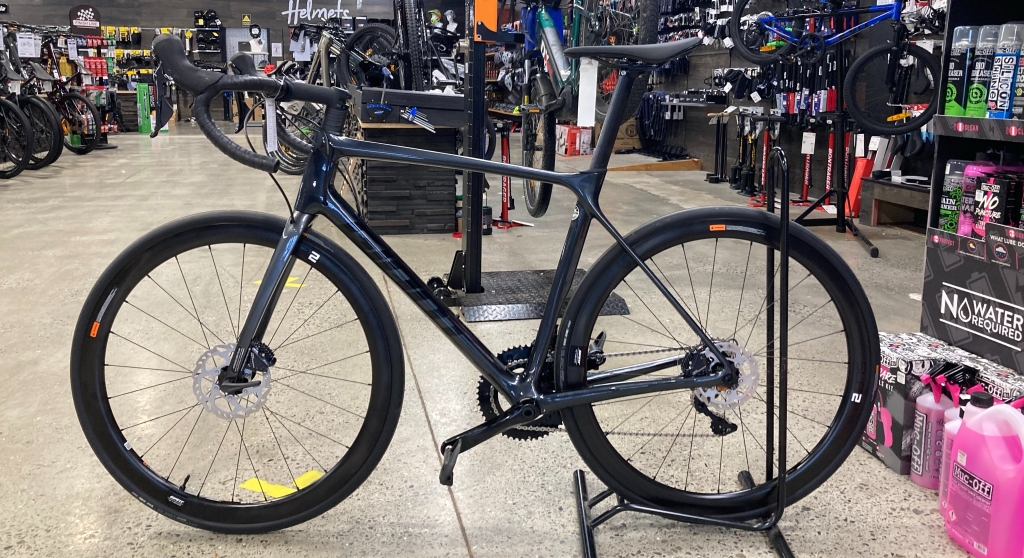
Having my bike stolen last year took the wind out of my sails more than I’d anticipated. I’d naively expected that things would get back to normal fairly quickly and either I’d get my bike back (ha!) or the insurance would come through and I’d be back on the road in a jiffy. Life doesn’t always work out as you’d expect. My ‘old’ bike is still out there somewhere (possibly part of this motherlode of stolen bikes), and while the insurance process was actually pretty good, my new bike took months to arrive. Before I knew it I was 5 kg heavier and my Strava feed had flatlined. But September heralded the arrival of a shiny new bike, and since then I’m well and truly back in the saddle.
My new bike is a cracker. Not top of the range, but comfortably at the racy end of mid-pack. I went with almost exact same model as the one that was stolen, just 10 years newer, mostly because in my price range the 2022 Giant TCR Advanced Pro 1+ offers some pretty appealing value for money.
Like the last one, it’s got a lightweight ‘pro’ grade carbon-fibre frame with a race-focused geometry. It has the tried-and-true Shimano Ultegra mechanical groupset, although with 11 gears instead of the 10 my old bike had. Bike nerds will quickly point to differences in the shapes of some of the tubes (a little thinner here, a little thicker there) as knowledge of frame performance and aerodynamics has bounded ahead in the decade since I bought my last one. I opted for mechanical gears rather than the newer tech of the electronic gear shifting. I’m sure that if I’d gone electronic I wouldn’t regret it, but I like the fact I don’t have to charge any batteries, and that there’s still a mechanical cable connecting the shifters to the derailleurs. If I’m honest though, the price increase to the 12-speed Di2 version nearly half as much again as what I paid, and that was well beyond my budget.
The big difference compared to my last bike is in the wheels. When I bought my last bike disc brakes on road bikes was something that no sensible person would even think about, but these days you’re hard pressed to find one without them. Wheel rims no longer need to be shaped to cope with also having to be the brakes, so they can now be a little bit wider, much more aerodynamic, and made out of things that would otherwise make for a terrible braking surface, like carbon fibre. So my new bike has wheels that not that back in the day would have been super exotic and stratospherically expensive.
Disc brakes also means that tyres can be quite a bit different, and tubeless tyres with no innertubes is pretty much standard. I’ve quickly discovered there’s upsides and downsides to this. Upsides: small punctures fix themselves, as the tyres are loaded with a liquid sealant that quickly gums up any small holes. For commuting this is great, and more than once I’ve picked things like staples or small bits glass out of my tyre that previously would’ve meant a roadside tyre repair. Downside is that bigger holes that a patched innertube would fix no worries are potentially fatal for a tyre. Which is expensive.
The rims are also hookless. As the name suggests, they now come without the ‘hook’ around the rim that the tyre bead traditionally hooks into.

This has been a bit of a leap of faith for me, as it means that the only thing holding the tyre onto the rim is the non-stretchyness of the tyre bead, and the air pressure holding the tyre in shape. That feels slightly alarming, but it’s pretty standard on almost any other kind of wheel (cars, trucks, planes…) so it works, and I’ve learned to trust it. I think.
The nicest thing about them and the advances in our understanding of tyres and how they actually work, is that they run at much lower pressures. Tyre pressure is the only thing in my life that I still think of in imperial units (apart from maybe boat speed), and whereas I’d run my tyres on my old bike at something like 110 PSI or more, the recommended maximum on the new ones is 80 PSI, and I’ve learned to run them even lower, at around 70 PSI. Even 5 years ago that would be seen as ridiculously soft and prone to punctures, but a tubeless setup means that’s a thing of the past, and the softer pressures increase grip and rolling efficiency, making for a much more comfortable and zippy ride.
So all told it’s a pretty sweet setup. Fitness is coming back, and I’m out and about exploring the roads of Wellington. Can’t promise anything as exciting or as interesting as the roads of Paris, but it’s good to be back on the road.

Nice one! I’m still not sold on hookless, but that’s totally unfounded as if there was any issue at all, there’d be hundreds of horrendous failure reports flooding the internet. As you say, other tyre’d vehicles use them. A fried of mine as a 2022 TCR also and he’s had no issues with hookless rims/tyres. Enjoy the new ride!
LikeLike
Thanks! The hookless tyres that shipped with the bike (Giant’s own brand Gavia) seem Ok – easy to mount, even for a tubeless newbie, and in the 5 months or so of regular fast commuter riding they seem to be holding up OK. Disc brakes are a total game changer.
LikeLike